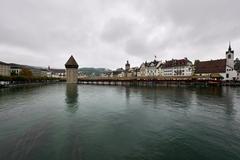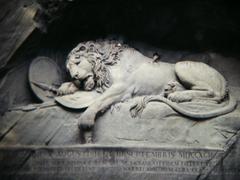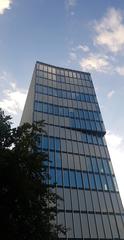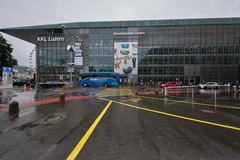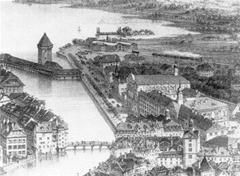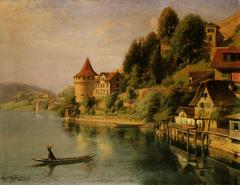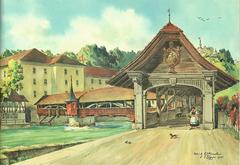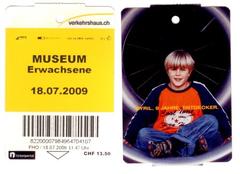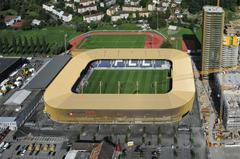
Church of St. Leodegar Lucerne: Visiting Hours, Tickets, and Historical Significance
Date: 04/07/2025
Introduction
The Church of St. Leodegar (Hofkirche St. Leodegar) stands as one of Lucerne’s most iconic landmarks, blending over 1,200 years of religious, cultural, and architectural heritage. Originally established as a Benedictine monastery in the 8th century, the church has witnessed the transformation of Lucerne from a monastic outpost into a bustling urban center. Dedicated to St. Leodegar—a 7th-century Frankish abbot and martyr—the church is both a spiritual hub and a cultural treasure, renowned for its unique fusion of Gothic and German Renaissance architecture. For visitors, it offers not only a profound cultural experience but also a window into the heart of Lucerne’s history and identity (myswitzerland.com, explorial.com).
Table of Contents
- Early Origins and Foundation
- Medieval Development and Gothic Predecessor
- Destruction and Renaissance Rebuilding
- Architectural Evolution and Features
- Religious and Cultural Significance
- Visiting Information: Hours, Tickets, and Tours
- Accessibility and Travel Tips
- Visuals and Media
- Notable Events and Milestones
- Legacy and Continuing Influence
- Frequently Asked Questions (FAQ)
- Plan Your Visit
- References
Early Origins and Foundation
The Church of St. Leodegar traces its roots to the mid-8th century, when it was established as part of a Benedictine monastery. This early foundation was pivotal in shaping Lucerne, attracting settlers and fostering the city’s growth as a regional center (myswitzerland.com). Initially dedicated to St. Maurice, the abbey soon came under the patronage of St. Leodegar and played a central role in the spread of Christianity and education in Central Switzerland (SpottingHistory).
Medieval Development and Gothic Predecessor
Throughout the Middle Ages, the church underwent several expansions. By the late medieval period, a grand Gothic structure with pointed arches, ribbed vaults, and imposing towers dominated the site. This church served both monastic and civic communities, becoming Lucerne’s principal parish church and a center for religious ceremonies and civic processions.
Destruction and Renaissance Rebuilding
A devastating fire in 1633 destroyed most of the Gothic church, sparing only the twin towers, St. Mary’s altar, and a few religious objects (myswitzerland.com). Reconstruction between 1633 and 1639 produced a rare example of German Renaissance architecture north of the Alps, combining the surviving Gothic towers with a Renaissance nave and choir (explorial.com). The luminous white stone interior, gilded altars, and finely carved wooden pews reflect the Counter-Reformation’s artistic and religious fervor.
Architectural Evolution and Features
Exterior and Facade
Perched on a gentle hill overlooking Lake Lucerne, the church’s twin Gothic towers remain a defining feature (explorial.com). The Renaissance facade is adorned with sculptural reliefs, including a statue of St. Michael the Archangel and the coat of arms of the Habsburgs, symbolizing the city’s alliances (wanderineurope.com).
Interior
The basilica-style layout measures approximately 60 meters in length, with a bright, airy nave and side aisles illuminated by large windows (wikipedia). Ornate wooden pews on the south side echo past social hierarchies, while the main altar—dedicated to St. Leodegar and St. Maurice—serves as the spiritual heart. Intricate gilded statuary, side altars to various saints, and a commemorative plaque to Ludwig Pfyffer von Altishofen enrich the sanctuary (nomads-travel-guide.com).
Pipe Organ
The grand pipe organ, with 4,950 pipes, is among Switzerland’s most acclaimed and is regularly featured in concerts and services (trip.com).
Religious and Cultural Significance
The church’s history is inseparable from Lucerne’s Catholic identity, particularly during the Counter-Reformation. Lucerne became a Catholic stronghold, and St. Leodegar served as a center for major religious and political events. Ludwig Pfyffer von Altishofen, who facilitated the arrival of the Jesuits, is honored inside the church for his role in strengthening Lucerne’s Catholic institutions (myswitzerland.com). Today, the church remains an active parish, hosting services, concerts, and community gatherings.
Visiting Information: Hours, Tickets, and Tours
- Visiting Hours: Generally open daily from 7:00 to 19:00; check the official site for holiday or special event variations.
- Admission: Free; donations are welcome.
- Guided Tours: Available via Lucerne’s tourist office and sometimes on-site. Book in advance, especially during peak seasons.
- Photography: Permitted without flash; be mindful during services.
Accessibility and Travel Tips
- Location: Centrally located at St. Leodegarstrasse 6, 6006 Lucerne, within easy walking distance of the Old Town and Lake Lucerne.
- Public Transport: Easily accessible by bus or on foot from the city center; parking nearby is limited.
- Accessibility: Wheelchair accessible with ramps and wide entrances. Assistance is available upon request.
- Nearby Attractions: Chapel Bridge, Lion Monument, Musegg Wall, and Swiss Museum of Transport are all within a short walk.
Visuals and Media
High-quality photos and virtual tours are available via Lucerne tourism resources. Suggested alt tags for images: “Church of St. Leodegar facade,” “Lucerne historical sites,” and “St. Leodegar pipe organ.”
Notable Events and Milestones
The church has hosted royal visits, ordinations, weddings, funerals, and major religious and civic celebrations. Restoration efforts over the decades have preserved its historic and artistic legacy, ensuring its continued vibrancy as both a worship space and cultural venue (myswitzerland.com).
Legacy and Continuing Influence
From its medieval monastic roots to its Renaissance transformation, the Church of St. Leodegar is a living symbol of Lucerne’s resilience and faith. Its blend of architectural styles, preserved relics, and ongoing community role make it essential for understanding Lucerne’s identity.
Frequently Asked Questions (FAQ)
Q: What are the Church of St. Leodegar’s visiting hours?
A: Typically 7:00 to 19:00 daily; confirm on the official website for seasonal variations.
Q: Is there an entrance fee?
A: No, admission is free.
Q: Are tours available?
A: Yes, through Lucerne’s tourist office or by arrangement.
Q: Is the church accessible for wheelchairs?
A: Yes, with ramps and accessible entrances.
Q: Can I take photos inside?
A: Yes, but avoid flash and respect services.
Q: What nearby attractions are recommended?
A: Chapel Bridge, Lion Monument, Musegg Wall, and Old Town.
Plan Your Visit
To make the most of your trip, check current hours and events on the official tourism page. For in-depth exploration, download the Audiala app for audio guides and up-to-date visitor information.
Enhance your itinerary with visits to the Chapel Bridge, Lion Monument, and other cultural highlights nearby. For more travel inspiration, follow our social media channels.
Summary
The Church of St. Leodegar is more than an architectural masterpiece; it is a living chronicle of Lucerne’s spiritual and cultural journey. Its harmonious blend of Gothic and Renaissance elements, preserved relics, and vibrant community role offer an immersive experience for all visitors. With free admission, central location, and proximity to other attractions, it is a cornerstone of any Lucerne itinerary. Plan your visit to explore this remarkable testament to Switzerland’s enduring heritage (myswitzerland.com).











